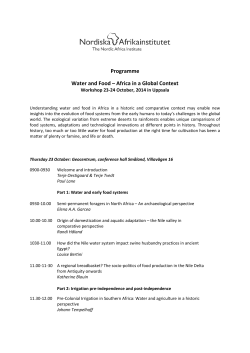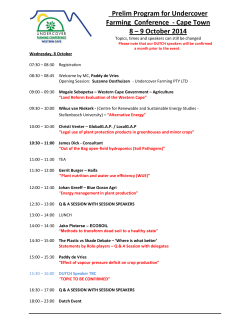
Remote Sensing for Command Area Management Remote Sensing
Remote Sensing for Command Area Management Satellite Remote Sensing & GIS for Irrigation Management Prof. D. Nagesh Kumar Dept of Civil Engg IISc, Bangalore, India URL: http://civil.iisc.ernet.in/~nagesh Remote Sensing for Command Area Management ¾ ¾ ¾ ¾ ¾ Assessment of water availability in reservoirs for optimal management of water to meet the irrigation demand Identifying, inventorying and assessment of irrigated crops Determination of irrigation water demand over space and time Distinguishing lands irrigated by surface water bodies or by ground water withdrawals Estimation of crop yield Remote Sensing for Command Area Management (Contd..) ¾ Water logging and salinity problems in irrigated lands ¾ Irrigation scheduling based on water availability and water demand ¾ Evapotranspiration studies ¾ Irrigation system performance evaluation Spectral Signature of Major Crops 1 Derivation of Bio-physical Parameters Derivation of Crop Parameters useful for Irrigation Management Water Management Information that can be Derived from Remote Sensing Case Study –1 Rajolibanda Diversion Scheme (RDS) • Inter state project between Karnataka and AP on Tungabhadra river in Krishna river basin upstream of Srisailam project. • 143 km long left bank main canal • Initial 42.6 km in Karnataka consisting of 12 distributaries • Distributaries 12A to 40 in AP • Ayacut of 35,410 ha – Kharif Season – Rabi Season – Perennial Crops Problems in RDS command - 14,215 ha. - 19,332 ha - 1,863 ha. Index Map of RDS Source of water supply is located in another state Result of water releases reducing in magnitude (annually) • Concentration of paddy in head reaches • Mid and tail end reaches receiving insufficient water supplies leading to violations of Command Area Development tenets • Due to insufficient water availability in the tail end stretches, reduced crop acreages are reported, with portions of ID crops subjected to moisture stress. 2 FCC for Rabi Season (1991-92) Distributary-wise Crop-group Areas (ha) during Kharif 1992 Accumulated Releases for Kharif 1991 Accumulated Water Requirements for Kharif 1991 Satellite Assessed Area Field Reported Area 3 Comparison Case Study - 2 Irrigation Management in Bhadra Project Command Area, Karnataka • Bhadra Dam - in Chickmagulur District • Bhadravati, Malebennur & Davangere Div. • Paddy & Non Paddy Crops in Rabi Season Satellite Assessed Area Field Reported Area National Water Management Plan (NWMP) IRS LISS-I data (Path-row: 27-58 & 27-59) • Pre NWMP Vs Post NWMP (after 1988) Location map of Bhadra Command Area False Color Composite Image of Bhadra Command area of 20 Feb 1993 FCC Image of Bhadra Command area of 14 March 1993 FCC Image of Bhadra Command Area of 16 April 1993 4 Classified image of 14th March 1993 IRS-1A Image of Bhadra Command Area of 27 April 1993 Classified Multi-date Imagery Classified image of 20 Feb Classified image produced by PFCM algorithm using three date NDVI images Classified image of 14 Mar Increase in Crop Area (in Hectares) after NWMP DIVISION 1988 1989 1990 Davengere 15,848 32,222 34,205 Malabennur 12,677 18,868 Total 28,525 51,090 28,240 62,445 5 Satellite Derived Cropping Pattern for Rabi 1992-93 Season (in Hectares) Non Paddy Total Bhadravathi 9,290 (58%) 7,330 (42%) 17,250 Malabennur 25,604 (81%) 6,134 (19%) 31,738 Davengere 25,869 (66%) 13,567 (34%) 39,436 DIVISION Paddy Estimation of Yield NDVI Image • Normalised Difference Vegetation Index • (Reflectance in NIR – Red) / (Ref. in NIR + Red) • (Band 4 - Band 3) / (Band 4 + Band 3) NDVI = imdivide ( imsubtract (I4, I3), imadd (I4, I3)); Regression Analysis Paddy Yield : 61.70 to 62.21 quintals/ha • Yield = - 5.89 + 0.234 NDVI (S.E.: 0.037) Estimation of Yield Contd.. Paddy Yield (quintals/ha) • Malabennur Division 61.70 to 62.21 • Davangere Division 51.66 to 52.14 6 Distributarywise Paddy Performance (Rabi 1992-93) Summary Satellite Remote Sensing can be Effectively used for Irrigation Management 7
© Copyright 2025












